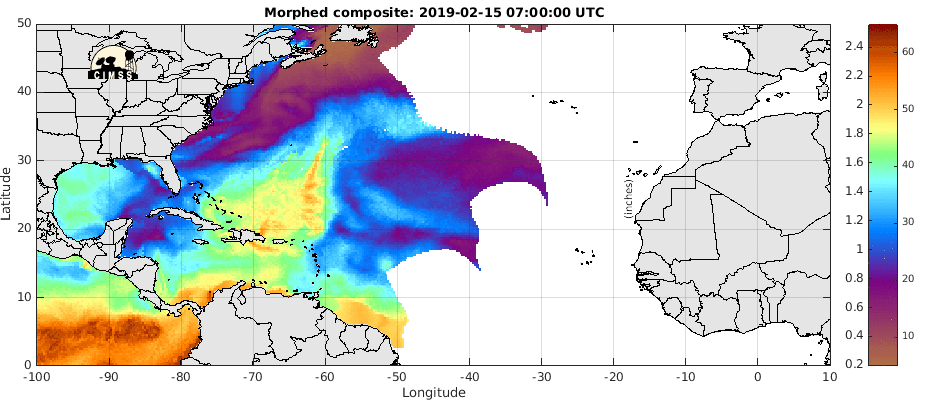wxman57 wrote:I'm not seeing much indication of an LLC on recon obs. I place the weak cloud swirl near 15.35N/76.27W. That appears to be what's left of the center.
Agree and this "center" is consistent with the microwave image AJC3 posted earlier.
Moderator: S2k Moderators
wxman57 wrote:I'm not seeing much indication of an LLC on recon obs. I place the weak cloud swirl near 15.35N/76.27W. That appears to be what's left of the center.

JamesCaneTracker wrote:wxman57 wrote:I'm not seeing much indication of an LLC on recon obs. I place the weak cloud swirl near 15.35N/76.27W. That appears to be what's left of the center.
Your the expert not me but it stands to reason that they found a LLC if they released a VDM AND there is a Wind Shift in the area of the VDM...


Shuriken wrote:I still maintain that all the dry air enthusiasts (including the NHC, which I am disappointed in) are flat-out wrong (as in: totally 100% wrong) -- the precipitable water associated with Ernesto is even higher this morning that it was yesterday.
This storm is swimming in a boatload of juicy air, but it just won't go UP.
Some other culprit is responsible, and I'm picking high-altitude cap. Yesterday, for several glorious hours, Earnesto flared at 200mb and we thought it really would take off. Today, it's being smothered again by a big invisible blanket.
http://tropic.ssec.wisc.edu/real-time/m ... t72hrs.gif
Hurricane Jean scraped along South American half onshore as a TS, and held together to blow up in the Gulf of Panama and cream Nicaragua as a cat-4 in 1988.jinftl wrote:Has there been an analysis of how many developing storms struggled like Ernesto has while traversting the Carribbean Sea at a very low latitude (almost Aruba latitude) with the South American landmass not far to the south? Systems that hadn't really fully developed before they passed the Islands (Ivan doesn't count then - he was a beast by Barbados) and paralleled the coast of Venezuela and Colombia say at or south of 15N and mysteriously never got it together?

[/quote]Ubiquitously they were in the process of recurving, and that typically implies increasing shear and elimination of equator-ward exhaust channels. (Contrast to Hugo, which was not recurving and was intensifying at landfall.)Kind of reminds me of the study that was done that found 11 of 12 storms of Cat 3 intensity or higher weakened considerably in the final 12 hours as they approached the northern Gulf Coast...and the huge landmass that is the U.S.
Ubiquitously they were in the process of recurving, and that typically implies increasing shear and elimination of equator-ward exhaust channels. (Contrast to Hugo, which was not recurving and was intensifying at landfall.)[/quote]Shuriken wrote:Hurricane Jean scraped along South American half onshore as a TS, and held together to blow up in the Gulf of Panama and cream Nicaragua as a cat-4 in 1988.jinftl wrote:Has there been an analysis of how many developing storms struggled like Ernesto has while traversting the Carribbean Sea at a very low latitude (almost Aruba latitude) with the South American landmass not far to the south? Systems that hadn't really fully developed before they passed the Islands (Ivan doesn't count then - he was a beast by Barbados) and paralleled the coast of Venezuela and Colombia say at or south of 15N and mysteriously never got it together?Kind of reminds me of the study that was done that found 11 of 12 storms of Cat 3 intensity or higher weakened considerably in the final 12 hours as they approached the northern Gulf Coast...and the huge landmass that is the U.S.
OK, I submit into evidence the precipitable water image above. -- That IS why I included it in the first place. Do you see any dry air intruding INTO Ernesto? No. It's-just-not-there.vbhoutex wrote:Shuriken wrote:I still maintain that all the dry air enthusiasts (including the NHC, which I am disappointed in) are flat-out wrong (as in: totally 100% wrong) -- the precipitable water associated with Ernesto is even higher this morning that it was yesterday.
This storm is swimming in a boatload of juicy air, but it just won't go UP.
Some other culprit is responsible, and I'm picking high-altitude cap. Yesterday, for several glorious hours, Earnesto flared at 200mb and we thought it really would take off. Today, it's being smothered again by a big invisible blanket.
http://tropic.ssec.wisc.edu/real-time/m ... t72hrs.gif
Maintain all you want. I can't find one met that would agree with you. And until you can provide some sort of proof that "they are 100% wrong" I would watch what you are saying about the NHC and for that matter every other pro-met. I saw it yesterday as did others. You are welcome to your opinions, but I have yet to see you provide any proof!!


jinftl wrote:Has there been an analysis of how many developing storms struggled like Ernesto has while traversting the Carribbean Sea at a very low latitude (almost Aruba latitude) with the South American landmass not far to the south? Systems that hadn't really fully developed before they passed the Islands (Ivan doesn't count then - he was a beast by Barbados) and paralleled the coast of Venezuela and Colombia say at or south of 15N and mysteriously never got it together?

OK, I submit in evidence the precipitable water image above. -- That IS why I included it in the first place. Do you see any dry air intruding INTO Ernesto? No. It's-just-not-there.
(They throw these satellites up, and nobody uses 'em. <shaking head>)




Users browsing this forum: No registered users and 15 guests